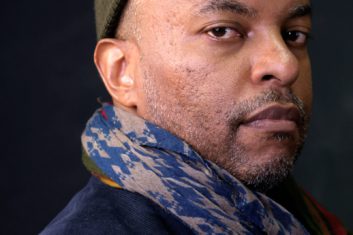I began my internship on January 8, 2015. As a multi-disciplinary artist, I felt that my placement in the 2nd grade class at P.S. 676, The Red Hook Neighborhood School was a perfect fit for me. The residency has three Teaching Artists at the helm, each with a different artistic background; Renee Flagler, Poet; Pamella Allen, Visual Artist; Adia Whitaker, Dance.
The evening before my internship began, Pamella and I met at the closing party for the Guggenheim Museum’s exhibition Zero: Countdown to Tomorrow, 1950s-60s. The growing community of Teaching Artists in New York lends itself to these kinds of chance encounters. That connection allowed me to feel at ease the next day in a classroom where I suddenly found myself the new kid in school again.
We began the class with an opening ritual where students partake in a Call and Response, singing and chanting “Awake, Alert, Alive, Enthusiastic” while holding correlating body parts associated with each word. In this ritual, I observed the impact Adia had on the class in lieu of her physical presence in the room – she is currently on maternity leave. It was wonderful to witness the small intentional ways that my mentors honored the practice of kinesthetic learning (learning through movement/body language) in their lesson plans, during their opening ritual. This ritual included visual imagery, verbal description, and kinesthetic dynamics for a robust opening ritual.
The first day of my internship was for observation. Watching my mentors at work made me think of how hard my fellow trainees and I worked to plan our mock lesson last November. We took pains to make sure that each activity would give the students enough time to learn and explore. But that was in a TATIP workshop, this was a live classroom. On any given day, the class could enter 10-15 minutes late from a previous class, while the residency end-time remained unchanged. There is also absenteeism. Each scenario happened on my first day, which Illustrates the versatility and flexibility necessary in lesson planning.
The students showed up excited to work. Our primary challenge was getting the classroom focused, finding a balance between enthusiasm for making art and the space for reflection and sharing. Observing these students made it very clear that art has the power to inspire participation from the quietest, most disassociated students. Allowing for these bursts of creative energy, without letting the most vocal students dominate the room, is vital to establishing a balanced classroom for all learning types.
Our main activity showed me how to properly balance wild enthusiasm with the order needed to complete the day’s work.The students created a short poem based on London Bridge is Falling Down, which we collectively retitled The Brooklyn Bridge is Dancing Hip Hop. Using each stanza from the original sone, students wrote a few lines personalizing the poem based on elements they observed in their own neighborhoods in NYC. This activity focused the students on both the community in which they live and creative control of a familiar song. I watched as students who had previously rolled their eyes and refused to participate run up to the Teaching Artists to read their poems out loud. Since time was cut short that day, and the classroom teacher was very strict about the end of class, the students had to save their work for the next week.
These 2nd graders are much younger than I was when I was first exposed to Community-Word Project. My time in the classroom illustrated how necessary it is to supplement the curriculum with other methods of learning in order to enhance the education of these students. I experienced Community-Word Project in middle school and high school. I saw how important it is to cultivate the artist within at an early age. I had opportunities to do so in afterschool programs while growing up. Community-Word Project helps deepen connections between students’ passions and their process of absorbing the classroom curriculum.
Since it was my first day as an intern, I primarilty observed the students. I did, however, have the opportunity to directly engage with the students when they broke into smaller groups to write their poems. This reminded me why I work as both an educator and an artist.
I believe art is transformational and inherently educational. As an artist who worked in a museum education department while practicing dance and theater on the side, it felt like I had a foot in each ‘separate’ art world. I am confident that I can recognize when a student has interest in various disciplines, and I understand that when asked to write a poem, some students may instead prefer to draw. I observed one student who had a difficult time focusing on the poetry. He began to draw on his page. When I asked him if he was able to write his name, he gladly did, and then began to write more. It seemed the simple act of claiming that blank white space as his own, gave him permission to engage in the shared activity. This experience was a wonderful first for me. I am excited to continue strengthening my relationship with the students in Red Hook, Brooklyn and the Teaching Artists of Community-Word Project.
-Katrina De Wees, Dancer, TATIP Trainee



